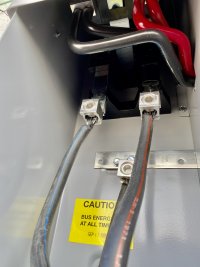-
Welcome to The Building Code Forum
Your premier resource for building code knowledge.
This forum remains free to the public thanks to the generous support of our Sawhorse Members and Corporate Sponsors. Their contributions help keep this community thriving and accessible.
Want enhanced access to expert discussions and exclusive features? Learn more about the benefits here.
Ready to upgrade? Log in and upgrade now.
You are using an out of date browser. It may not display this or other websites correctly.
You should upgrade or use an alternative browser.
You should upgrade or use an alternative browser.
An average day
- Thread starter ICE
- Start date
That could be, not what I was seeing though. I see a partial violation that I see a lot in the field. My last building official said I didn't need to make it a correction as long as the other parts are in order. We'll see what the next one says...Does a bare bulb that low on the wall need a guard?
Mech
REGISTERED
Joe B. - No air gap provided?
Not a bad idea. I would definitely say that it needs one.Does a bare bulb that low on the wall need a guard?
YesDo you see any other violations in this photo you shared?
Joe B. - No air gap provided?
Sediment trap location. 2019 CPC1212.9 & CMC1312.9 "...a sediment trap shall be installed downstream of the appliance shutoff valve as close to the appliance as practical, but before the flex connector..." Almost always see them installed the way it's shown here and the last BO said he didn't care as long as there was one and it's installed after the shutoff valve. I don't see the harm in having the flex connector first but technically it's a code violation. 2010 and 2013 codes don't mention the flexible connector, added in 2016 cycle.
Anybody else enforce this or have any idea why it was added? Do you see any harm in the sediment trap being after the flexible connector?
Anybody else enforce this or have any idea why it was added? Do you see any harm in the sediment trap being after the flexible connector?
Paul Sweet
SAWHORSE
Is this CPVC, or does California allow PVC for the relief valve discharge?
We do not allow PVC. We would not permit this configuration with the T&P stuck into the smitty drain pipe.Is this CPVC, or does California allow PVC for the relief valve discharge?
As to the sediment trap location....I was not aware of the "before the flex" code. Could it be that dirt might settle out in the corrugations like a sluice?
That was my thought, if the sediment trap is first (and installed properly) then it would allow sediment to collect at a maintainable point. If the flexible connector is doing the catching, like a sluice box, then it's not maintainable. I guess you could just replace the flexible connector. I also wonder if sediments would build up and restrict flow. Now the bigger question, ever heard of anybody actually opening up the sediment trap to clean it out? If so, did they find anything collected there? The only person I've ever heard say they did that was an HVAC guy who checks his own trap at home once a year and has never found anything in there. He said he's never checked another one.We do not allow PVC. We would not permit this configuration with the T&P stuck into the smitty drain pipe.
As to the sediment trap location....I was not aware of the "before the flex" code. Could it be that dirt might settle out in the corrugations like a sluice?
Mech
REGISTERED
Is the flexible connector any different than CSST for collecting debris?
They are probably functionally the same, although the flexible connectors are usually smaller in diameter, so they could be more likely to clog?Is the flexible connector any different than CSST for collecting debris?
Last edited by a moderator:
It went from this:
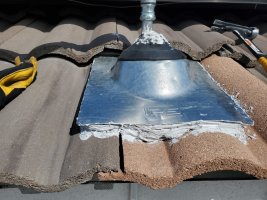
To this:
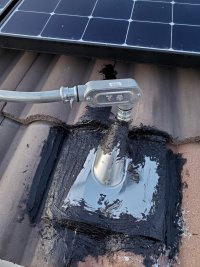
I provided a link to a roof jack that has a lead base and a pick your size rubber boot. The contractor sent this picture. I sent back "No". The peermit has a valuation showing $1000 per module and this is as good as it gets. I expect to hear from a supervisor over the one word reply. They should be pleased that I stuck to one word.
Update: April 5
Close enough to correct.
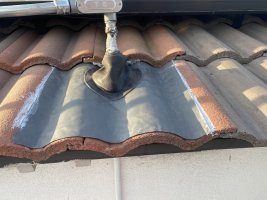

To this:

I provided a link to a roof jack that has a lead base and a pick your size rubber boot. The contractor sent this picture. I sent back "No". The peermit has a valuation showing $1000 per module and this is as good as it gets. I expect to hear from a supervisor over the one word reply. They should be pleased that I stuck to one word.
Update: April 5
Close enough to correct.

Last edited:
This was sent to me by a coworker. The picture shows two lugs under one screw. This is in an Eaton 200 amp disconnect. The disconnect label calls for a DS200GK. My initial reaction was that the configuration is unorthadox. Then I googled the part #. The kit is two lugs and one screw.
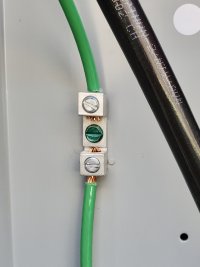
Click here for a link.

Click here for a link.
Last edited:
Mr. Inspector
SAWHORSE
No goop on the al wire
How do you enforce that? If the terminal is labled for aluminium, and you followed manufacturers instructions, that is all that is required by 2017 NEC 110.14.No goop on the al wire
Is there a manufacturers requirement that would make 110.3 (B) apply? Local amendment?
Not required unless manufacturers instructions call for it. That being said I use it.No goop on the al wire
Paul Sweet
SAWHORSE
I always specify conductive paste for connections of aluminum wiring, and I think a lot of engineers also specify it.
steveray
SAWHORSE
Fixed it....LOL! Happy Friday!I always specify conductive paste for connections of aluminum wiring, and I think a lot of engineers and electricians also eat it.
I always specify conductive paste for connections of aluminum wiring, and I think a lot of engineers also specify it.
There is a bit of difference between job specs & code requirements, job specs have be complied with on that job, code requirements have to be followed on every job they apply to.
fatboy
Administrator
That is a butcher job on the stripping......either a rookie, or a hack, or both!
A solar contractor claims to have replaced a 125 amp main breaker with a 100 amp main breaker in order to stay within the 120% rule with 30 amps of solar.
There is no panel label. There is four different manufacture's circuit breakers installed. The breakers installed by the solar co. do not appear to be new. The bus looks like it has something going on that I am not sure about.
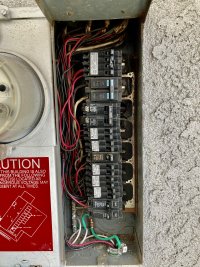
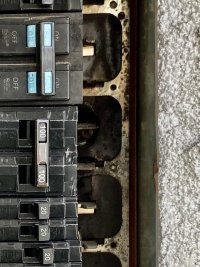
There is no panel label. There is four different manufacture's circuit breakers installed. The breakers installed by the solar co. do not appear to be new. The bus looks like it has something going on that I am not sure about.


Last edited:

